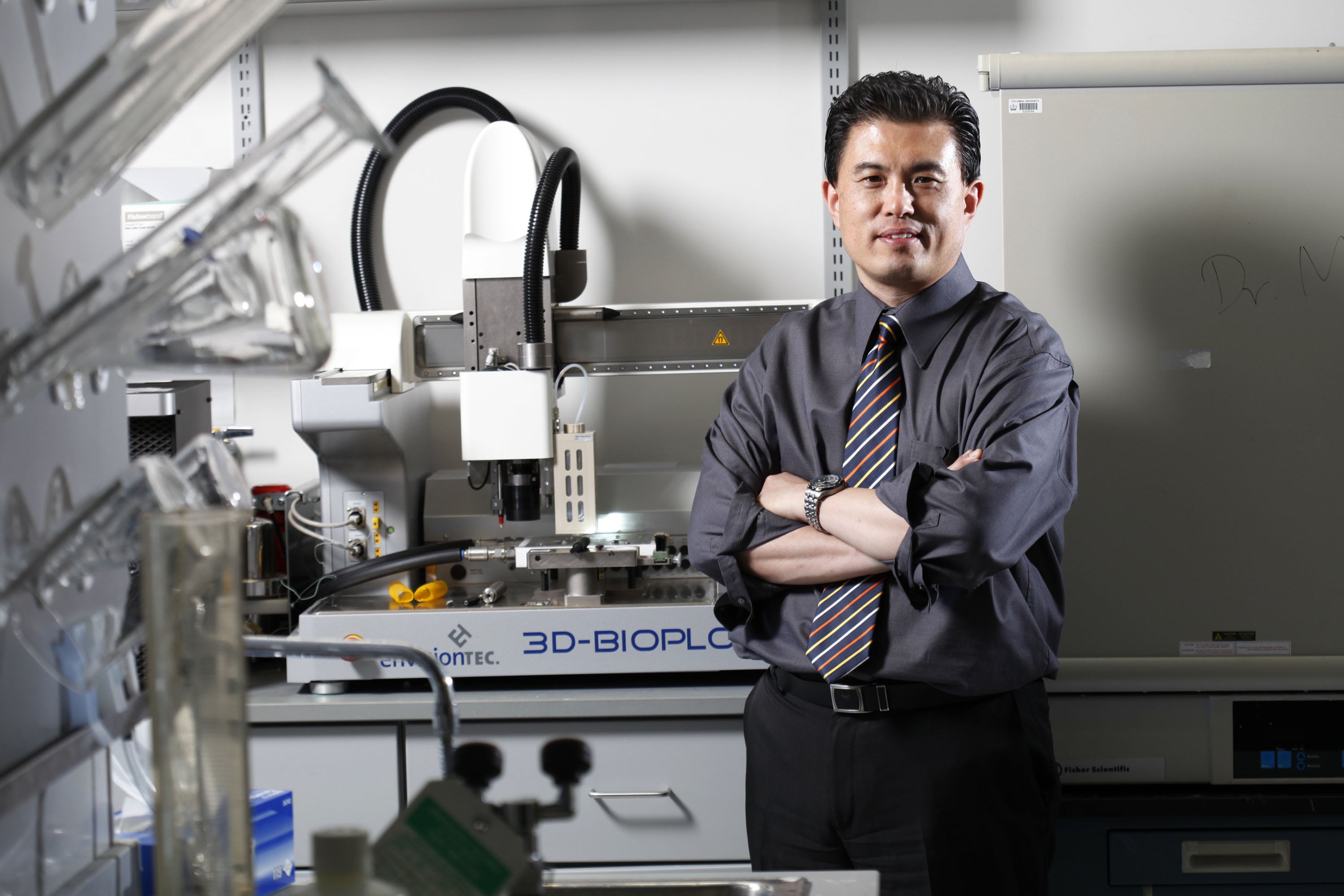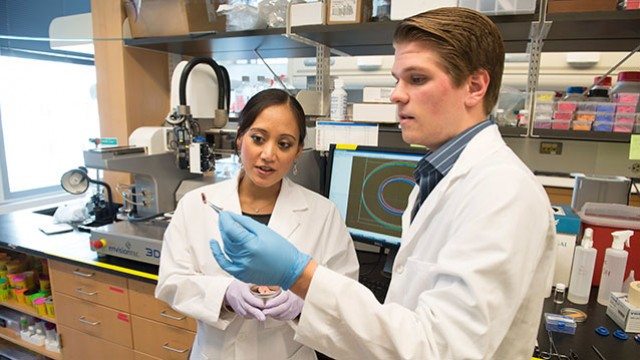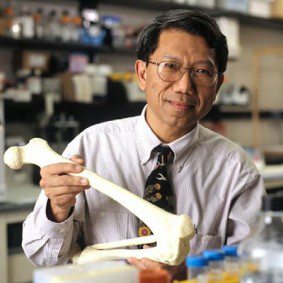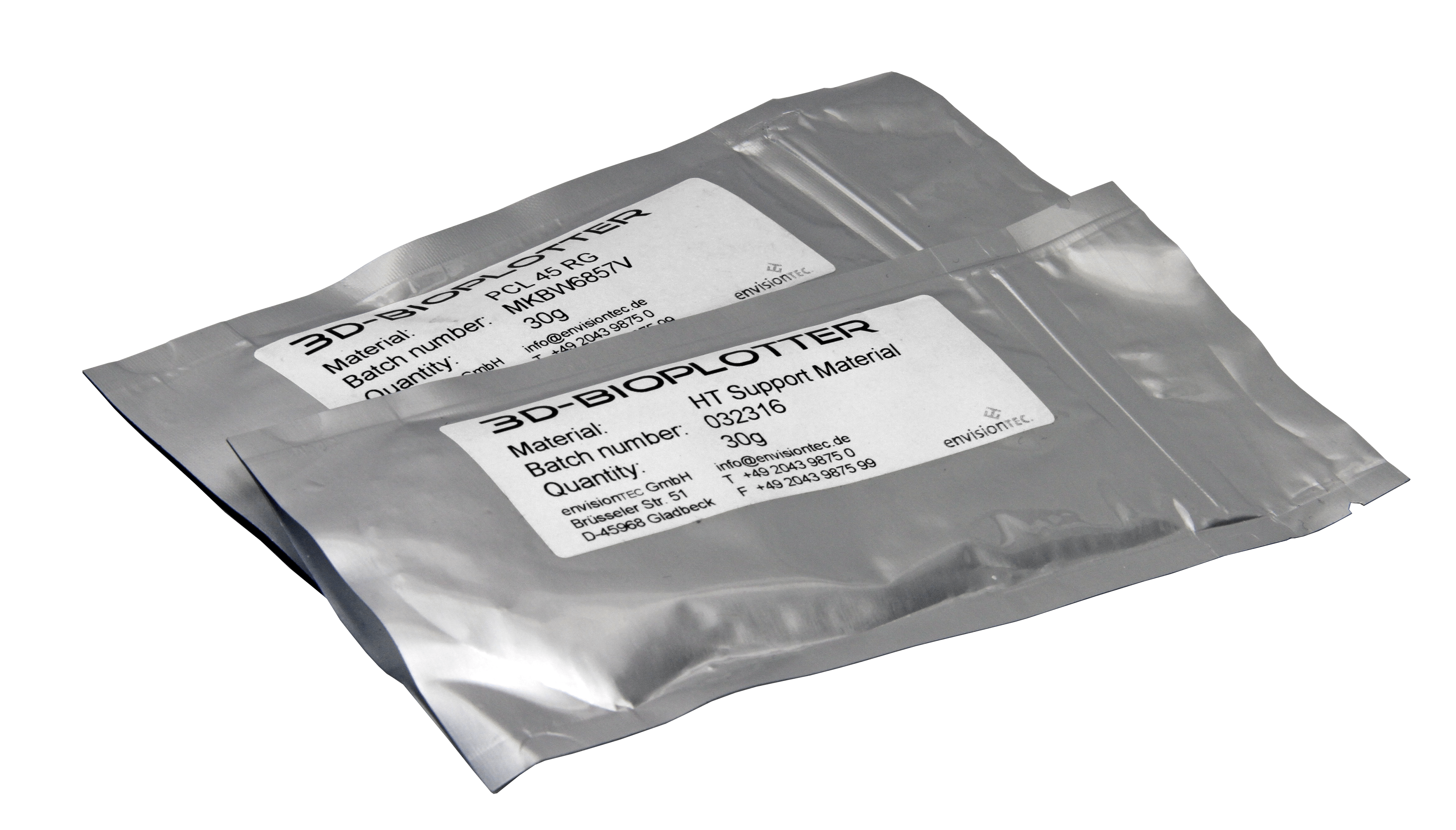Proud to Offer the World-Leading 3D Bioprinter —
The biofabrication industry is growing fast and holds the promise of truly improving and saving human lives.

A scaffold for meniscus repair was printed on an EnvisionTEC Manufacturer Series 3D-Bioplotter from a custom tyrosine-derived polymer at the Center for Biomaterials at Rutgers, The State University of New Jersey in collaboration with the Orthopaedic Research Laboratory at Rutgers Biomedical and Health Sciences. This 3D printed implant is currently under commercial development by NovoPedics, Inc.
As such, EnvisionTEC is proud to offer its 3D-Bioplotter in three levels of accessibility — the Starter, Developer and Manufacturer — for the automated production of tissues and organs to address complex health challenges in medicine. Our bioprinter is fueling ongoing medical research around the world, as seen in this sampling of technical papers.
Bioprinting with the 3D-Bioplotter allows medical researchers to combine cells, gels, fibers, polymers, ceramics, metals and more into a single scaffolded object that can replace a diseased, injured or missing body part, from tissue and bone to organs.
In fact, biofabrication research is being done in a wide range of areas:
• skin
• cartilage
• bone
• Blood vessels
• organs such as the heart, kidney, placenta and ovaries
• drug and nutrient delivery
With biofabrication, a platform must be trusted to accurately place cells and mix materials in a sterile, temperature-controlled environment, as the 3D-Bioplotter has been doing for more than a decade. It also should be easy for researchers to use and manipulate for their various research needs.

Dipl. Chem. Carlos Carvalho, Process & Material Development, EnvisionTEC.
“I personally find it fascinating seeing what researchers will do with it next,” said Carlos Carvalho, who led the development of the fourth generation of the 3D-Bioplotter and has worked on the bioprinter since its infancy at the University of Freiburg in Germany. Carvalho cited as an example a 2012 paper about 3D printing graphene that was done with the 3D-Bioplotter as launching an entirely new area of research. The EnvisionTEC bioprinter has also been used to fabricate hyperelastic bone, ovary implants, a placenta model and is being used in bone regeneration research.
With three levels of functionality, this family of printers processes open-source biomaterials using air or mechanical pressure to a syringe, which can fabricate scaffolds to create tissue, organs and more. Our bioprinters are extremely accurate with X-Y repeatability down to 1 μm. All models have been designed for use in a sterile biosafety cabinet, meet standards for clinical trials and offer build sizes up to 192.4 cubic inches.
See how our customers, which includes the U.S. Food and Drug Administration, are using their 3D-Bioplotters below.
Doctors Trust EnvisionTEC
3D Bioprinting with Shah Lab
Northwestern University’s Shah Lab is breaking new ground with EnvisionTEC’s 3D-Bioplotter. 3D printing to help reshape the future and save lives. shahlab.northwestern.edu
The FDA’s Role in Overseeing 3D Printing in Medicine
Learn how the FDA works with 3D printing for innovative research and regulation.
Heart Valve Biofabrication
Demonstration video on how to use EnvisionTEC’s 3D-Bioplotter to create an aorta leaflet heart valve. Showcasing the automatic switching material, software settings and dissolvable support material. Allowing patients with cardiac disease to live happier refreshed lives.
3D Printing a Prosthetic Hand
Witness as our biofabrication expert demonstrates how you can combine EnvisionTEC’s ULTRA 3SP® & 3D-Bioplotter® machines to create a fully functional prosthetic hand.
Models based on gyrobot.co.uk/
3D Printers for the Biofabrication Industry
The 3D-Bioplotter Starter Series is designed for research groups new to the field of tissue engineering with few requirements in parallel material processing and automation. It consists of the same basic hardware and software as the other two 3D-Bioplotter models, but lacks modular capability and platform temperature control. The 3D-Bioplotter Starter Series comes with 2 fixed high-temperature heads.
The 3D-Bioplotter® Developer Series is designed for research groups new to the field of tissue engineering, as well as for specialized use, where limited capability may still meet requirements. It consists of the same basic hardware and software as the Manufacturer Series but with reduced park position functionality. It is still capable of using multiple modular head types and an optional heated platform.
The 3D-Bioplotter Manufacturer Series was designed as a tool for advanced tissue engineering and also for use in a production environment. It is the most versatile and advanced of the 3D-Bioplotter options and is capable of utilizing up to 5 materials in a build as well as UV curing capabilities and both heated and cooled platform options.
3D Printing Materials for the Biofabrication Industry
Silicone 60A UV MG is a biocompatible, bio-inert, non-biodegradable liquid silicone rubber that is cured with a UV light and delivers a Shore A hardness of 60. A transparent material, it can also be mixed with pigments. Approved only for short-term use in the body (29 days or less), it is suitable for microfluidics, wound dressings, bio-sensor housings, and prototyping.
![]()
Medical grade Polycaprolactone (PCL) is a biodegradable thermoplastic polyester that is processed at high temperatures. It is suitable for both short-term and long-term use in the body (longer than 29 days) and ideal for applications such as bone regeneration, cartilage regeneration, drug release and hybrid scaffolds.
![]()
Medical grade Polycaprolactone (PCL) is a biodegradable thermoplastic polyester that is processed at high temperatures. It is suitable for both short-term and long-term use in the body (longer than 29 days) and ideal for applications such as bone regeneration, cartilage regeneration, drug release and hybrid scaffolds.
![]()
This very versatile material can be used for numerous demo applications: from trying out new shapes and patterns using a cheap material; through making technical parts (e.g. gaskets); to medical device casings
![]()
This sugar derivative can easily be processed as a melt in prolonged jobs with no measurable degradation. The material is biocompatible and cell friendly, ensuring that residue material does not negatively affect the final object’s biological properties.
![]()
Polycaprolactone (PCL) is one of the most versatile thermoplastic materials for Tissue Engineering Applications. With little thermal degradation, it is an excellent material for large, time-consuming parts.
![]()
LT Support RG can easily be processed as a hydrogel in short to medium long jobs. The material is biocompatible and cell friendly, ensuring that residue materials do not negatively affect the final object's biological properties.
![]()




 With MRI scans, we could synthesize a 3D printed meniscus scaffold, which could be made exactly at the size and dimensions of the meniscus that needs to be replaced. Then we delivered two proteins to stimulate the body’s internal stem cells to regenerate the meniscus. We put that scaffolds with the two proteins inside the sheep meniscus that was replaced. (Within about 6 weeks, on average, the meniscus was regenerated in the sheep).
With MRI scans, we could synthesize a 3D printed meniscus scaffold, which could be made exactly at the size and dimensions of the meniscus that needs to be replaced. Then we delivered two proteins to stimulate the body’s internal stem cells to regenerate the meniscus. We put that scaffolds with the two proteins inside the sheep meniscus that was replaced. (Within about 6 weeks, on average, the meniscus was regenerated in the sheep). Many of the other 3D printers don’t have the necessary control. Printing the proprietary polymer we’re using for the implant requires high temperature and high pressure to get a very fine filament, which other printers aren’t capable of achieving with the same level of reproducibility. So, not only could we not manufacturer this implant without 3D printing, we couldn’t manufacturer it without this 3D printer. We use the EnvisionTEC not only to print the actual scaffolds being implanted or being tested, but also devices that facilitate the research. ... I can trust my undergraduates to run this printer, because it’s reliable, the interface is easy, and it has a lot of safeguards built-in against user error. It’s definitely the iPhone of printers. It doesn’t let you break it.
Many of the other 3D printers don’t have the necessary control. Printing the proprietary polymer we’re using for the implant requires high temperature and high pressure to get a very fine filament, which other printers aren’t capable of achieving with the same level of reproducibility. So, not only could we not manufacturer this implant without 3D printing, we couldn’t manufacturer it without this 3D printer. We use the EnvisionTEC not only to print the actual scaffolds being implanted or being tested, but also devices that facilitate the research. ... I can trust my undergraduates to run this printer, because it’s reliable, the interface is easy, and it has a lot of safeguards built-in against user error. It’s definitely the iPhone of printers. It doesn’t let you break it. My lab primarily primarily focuses on developing new functional materials for 3D printing. … We have printable hydrogel systems so that we can create complex organ and tissue systems, and we also have our particle based inks where we have the ability to print metals to ceramics to biologic tissues. The ultimate objective and goal of my lab is to develop system that end with 3d printed products that can be accessible to many people. That’s important, especially in the biomedical realm, where cost makes a huge difference.
My lab primarily primarily focuses on developing new functional materials for 3D printing. … We have printable hydrogel systems so that we can create complex organ and tissue systems, and we also have our particle based inks where we have the ability to print metals to ceramics to biologic tissues. The ultimate objective and goal of my lab is to develop system that end with 3d printed products that can be accessible to many people. That’s important, especially in the biomedical realm, where cost makes a huge difference. This research is the first success of living human cartilage tissue composed atop a chip using 3D printing.
Though the research isn’t ready to take the place of non-organic replacement joints, as Tuan has said, “It’s very promising and looking good.” At the least the research developed by the team can help scientists better understand what causes osteoarthritis and how to combat degenerative bone diseases with drug therapy.
Rocky Tuan, PhD, is a professor and executive vice chairman of the department of orthopedic surgery as well as the director of the Center for Cellular and Molecular Engineering at the University of Pittsburgh School of Medicine developing 3D printed cartilage with the EnvisionTEC Perfactory®.
This research is the first success of living human cartilage tissue composed atop a chip using 3D printing.
Though the research isn’t ready to take the place of non-organic replacement joints, as Tuan has said, “It’s very promising and looking good.” At the least the research developed by the team can help scientists better understand what causes osteoarthritis and how to combat degenerative bone diseases with drug therapy.
Rocky Tuan, PhD, is a professor and executive vice chairman of the department of orthopedic surgery as well as the director of the Center for Cellular and Molecular Engineering at the University of Pittsburgh School of Medicine developing 3D printed cartilage with the EnvisionTEC Perfactory®.





